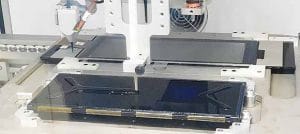The Visteon iterations to the SmartCoreTM cockpit domain controllers are
exciting. Sumesh Soman looks at the key integrations paving the way for next-gen driving experiences.
The AdrenoX derives its genes from the Adreno Graphics Processing Unit (GPU) that first came onto the scene in 2018, at the Consumer Electronics Show (CES). Powered by automotive solutions from Qualcomm Technologies Inc., it is crucial to Visteon’s run for leadership in the cockpit electronics segment. A scalable hardware and software stack, it is aimed at supporting advanced cockpits, and it succeeds in doing so on first impressions.

On the supply side, it is built on the foundation of offering high levels of performance, cost and reliability that can be tailor-made for Original Equipment Manufacturer (OEM) requirements, for their respective vehicle platforms. Stated Aashish Bhatia, Regional Vice President and General Manager, Visteon India, “We are proud that our engineering and manufacturing capabilities in India, combined with our global leadership in cockpit domain controllers has resulted in creating a personalised digital cockpit,” case-in-point being the inclusion on a recently launched Sports Utility Vehicle (SUV). “Visteon’s technology elevates user experience by keeping occupants safe, informed, engaged and entertained,” he claimed.
The DNA of AdrenoX
According to Pramod Nanjundaswamy,
Director – Product Delivery, Visteon, the AdrenoX is an intelligent cockpit technology powered by the SmartCoreTM which fires up the in-cabin cockpit screens and telematics. In its earlier generation SmartCore™ powered virtualised graphic engine ran three displays and one head-up display claimed to deliver an enhanced driver and passenger experience through a single, seamless Human-Machine Interface (HMI). It made it possible to collate content from different safety-critical and infotainment domains, including media applications and navigation on all connected displays. Secure and seamless were a priority even then. Back then, the second generation cockpit domain controller was designed to integrate infotainment, instrument clusters, information and head-up displays, Advanced Driver Assistance Systems (ADAS) and connectivity into a single Electronic Control Unit (ECU). This foundation was shared to be scalable from assisted to autonomous driving applications.

Claimed to have been designed to meet the need for an intuitive and personalised digital experience of the new-age tech-savvy consumers, it boasts of multi- display environments that can support a digital voice assistant, instrument cluster, infotainment, cloud connectivity, security and telematics. Taking the baton from Adreno, which ran on the Snapdragon 820A automotive platform, it builds on the DriveCore™ , an open platform consisting of the layers like hardware, middleware and frameworks. These are known to aid in development of the machine learning algorithms for object classification, detection, path planning and execution.
Leveraging technology
Visteon is leveraging its technological prowess across Artificial Intelligence (AI), connected car applications, cybersecurity, user experience and interior sensing. Visteon’s machine learning algorithms, for instance, are known to offer advanced perception, localisation and driver monitoring capabilities. Visteon is also known to leverage HTML5 and Android-based connected infotainment platforms, to facilitate built-in smartphone integration with CarPlay and Android Auto technologies. Notably, the company is able to tailor these for varied consumer cost points. It effectively means that what was restricted to the luxury vehicles at the top end of the spectrum have percolated to the segments below.

Visteon is also offering end-to-end cybersecurity by controlling design and development of the ECUs. It is able to not only securely manufacture but sustain the offerings with secure OTA updates. The adaptive Graphic User Interfaces (GUIs), the color, content and complexity of the cockpit are all built in a manner that it can be customised through change in parameters. OEMs thus are not required to carry out an additional asset development or go through with mid-cycle adjustments. The Driver Monitoring System (DMS) can be used by OEMs to offer identification of the drowsiness and distraction level of the driver. Visteon makes use of infrared camera-based solutions for facial recognition while deploying AI to monitor driver distraction, drowsiness, emotion, and head and eye gaze.
Visteon has won USD 3.2 billion in new business during the first half of the year. This includes a USD 640 million second-quarter expansion of a previously awarded digital cluster program, bringing total lifetime value for that program to USD 1.5 billion. Of the 50 plus product launches in the pipeline, globally, seven products are known to have been launched in the second quarter of financial year 2022 (Q2FY2022).

According to Sachin Lawande,Chief Executive Officer, Visteon, the strength of Visteon’s digital product portfolio supports the industry trends of digitalisation and connectivity, and has led to the company’s continued market outperformance even in a supply constrained environment. New business wins, product launch cadence are among the driving forces of the company’s continued long-term growth. ACI












